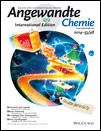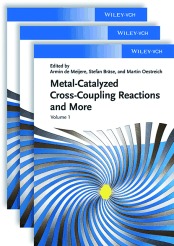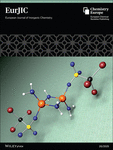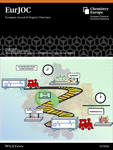Journal list menu
Export Citations
Download PDFs
Cover Pictures
Cover Picture: Development of Double-Perovskite Compounds as Cathode Materials for Low-Temperature Solid Oxide Fuel Cells (Angew. Chem. Int. Ed. 48/2014)
- Page: 12973
- First Published: 22 September 2014

Double-perovskite compounds are described by G. Kim and co-workers in their Communication on page 13064 ff. as a new class of cathode materials for solid oxide fuel cells. The enhanced stability of NdBa0.75Ca0.25Co2O5+δ can be ascribed to both the increased electron affinity of mobile oxygen species and the increased redox stability induced by Ca doping into the A site of NdBaCo2O5+δ.
Inside Cover: Catalytic Asymmetric Functionalization of Aromatic CH Bonds by Electrophilic Trapping of Metal-Carbene-Induced Zwitterionic Intermediates (Angew. Chem. Int. Ed. 48/2014)
- Page: 12974
- First Published: 26 September 2014

An asymmetric three-component reaction of N,N-disubstituted anilines, diazo compounds, and imines is catalyzed by RhII and a chiral phosphoric acid and affords α,α-diaryl benzylic quaternary stereocenters. In their Communication on page 13098 ff., W. Hu, D. Xing et al. report this functionalization of aromatic CH bonds with diazo compounds, which they compare with a “magic tea pot” that allows the mixing of three different tea bags into a wonderful tea.
Inside Back Cover: Dynamic Mirror-Symmetry Breaking in Bicontinuous Cubic Phases (Angew. Chem. Int. Ed. 48/2014)
- Page: 13293
- First Published: 24 September 2014

Two thermotropic bicontinuous cubic liquid-crystalline phases containing three or two networks were discovered. The triple-network phase displays a previously undiscovered feature: it is always strongly optically active even though the constitutive compound is achiral. In contrast, the “double gyroid”, containing only two networks, has no optical activity. As X. Zeng, G. Ungar, C. Tschierske et al. propose in their Communication on page 13115 ff., only in the double gyroid the opposing induced chiralities cancel out, while in the triple-network net chirality inevitably persists.
Back Cover: Unexpected Synergy between Magnetic Iron Chains and Stacked B6 Rings in Nb6Fe1−xIr6+xB8 (Angew. Chem. Int. Ed. 48/2014)
- Page: 13294
- First Published: 26 September 2014

Planar boron rings were predicted some years ago by scientists studying gas-phase boron clusters as building blocks for designing new molecular and solid-state materials. In their Communication on page 13174 ff., B. P. T. Fokwa et al. report experiments and density functional calculations used in a synergistic manner for the discovery of the new ferromagnetic material, Nb6Fe1−xIr6+xB8 (Tc=350 K), containing in its crystal structure iron chains embedded in stacked B6 rings.
Frontispiece
Frontispiece: Homogeneous Electrocatalytic Water Oxidation at Neutral pH by a Robust Macrocyclic Nickel(II) Complex
- First Published: 18 November 2014

Water Oxidation In their Communication on page 13042 ff., Z.-F. Ke, T.-B. Lu, and co-workers report a nickel-based homogeneous catalyst for water oxidation. This catalyst can efficiently electrocatalyze water oxidation at neutral pH in phosphate buffer.
Graphical Abstract
Graphical Abstract: Angew. Chem. Int. Ed. 48/2014
- Pages: 12977-12992
- First Published: 18 November 2014
Addendum
Addendum: Anti-Electrostatic Hydrogen Bonds
- Page: 12992
- First Published: 18 November 2014
News
Spotlights on our sister journals: Angew. Chem. Int. Ed. 48/2014
- Pages: 12994-12997
- First Published: 18 November 2014
Author Profile
News
Elected to the Academy of Europe: F. Lloret and P. Samorì / EuCheMS Lecture: C. Moberg and G. Férey / EuCheMS Award for Service: L. A. Oro / International Society of Electrochemistry Prizes: A. M. Bond, J. Rusling, M. Osawa, Y.-G. Guo, F. La Mantia, and Y. Wang
- Pages: 12999-13000
- First Published: 21 October 2014
Book Review
Metal-Catalyzed Cross-Coupling Reactions and More. 3 Volume Set. Edited by Armin de Meijere, Stefan Bräse and Martin Oestreich.
- Pages: 13001-13002
- First Published: 18 November 2014
Highlights
Homogeneous Catalysis
Iron-Catalyzed Hydrogenation of Esters to Alcohols
- Pages: 13004-13006
- First Published: 21 October 2014
Enzyme Catalysis
Protein Crystallography Using Free-Electron Lasers: Water Oxidation in Photosynthesis†
- Pages: 13007-13008
- First Published: 10 October 2014
Minireview
Polymer Sequencing
Reading Polymers: Sequencing of Natural and Synthetic Macromolecules
- Pages: 13010-13019
- First Published: 03 October 2014

Read the small print: Sophisticated sequencing methods have been developed for deciphering the sequences of proteins and nucleic acids. Can these tools be transfered to the characterization of monomer sequences in synthetic polymers? The techniques employed in both fields are compared and critically analyzed.
Review
Constrained Cyclic Peptides
Constraining Cyclic Peptides To Mimic Protein Structure Motifs
- Pages: 13020-13041
- First Published: 06 October 2014

Short peptides can be constrained by cyclization to recreate key folded elements of protein structure, like β-strands and β-sheets, α-helices, and turn motifs. Coupled with internal molecular constraints, cyclization has led to many protease-resistant, potent and target-selective, biologically active compounds for use in biology and medicine.
Communications
Water Oxidation
Homogeneous Electrocatalytic Water Oxidation at Neutral pH by a Robust Macrocyclic Nickel(II) Complex†
- Pages: 13042-13048
- First Published: 09 September 2014
Asymmetric Allylic Amination
Cooperative Catalysis by Palladium and a Chiral Phosphoric Acid: Enantioselective Amination of Racemic Allylic Alcohols†
- Pages: 13049-13053
- First Published: 10 October 2014

Teamwork enantioselectivity: An asymmetric amination of racemic allylic alcohols with various functionalized amines proceeded with high regio- and enantioselectivity under cooperative catalysis by the chiral phosphoric acid 1 and a palladium complex with the phosphoramidite ligand 2 (see scheme; R1=aryl, R2=alkyl or H; dba=dibenzylideneacetone). The transformation was efficient even with less reactive alkyl allylic alcohols.
Protein Engineering
Crowning Proteins: Modulating the Protein Surface Properties using Crown Ethers†
- Pages: 13054-13058
- First Published: 06 October 2014

Crowning proteins: By a combination of structural and biophysical methods, it was observed that crown ethers modify protein surfaces dramatically, stabilizing molecular interactions. Hence, crown ethers could potentially be used to modulate a wide range of protein surface behaviors, such as oligomerization, domain–domain interactions, and crystallization.
Near-Infrared Bioluminescence
A Dual-Color Far-Red to Near-Infrared Firefly Luciferin Analogue Designed for Multiparametric Bioluminescence Imaging†
- Pages: 13059-13063
- First Published: 29 September 2014

A stretched luciferin: Synthetic infra-luciferin is a dual-color, far-red to near-infrared (NIR) emitting analogue of beetle luciferin, which akin to native luciferin gives rise to different far-red to NIR emission maxima (up to λmax=706 nm) with different firefly luciferase mutants. This red-shifted bioluminescence is suitable for imaging in mammals with less attenuation than luciferin.
Perovskites
Development of Double-Perovskite Compounds as Cathode Materials for Low-Temperature Solid Oxide Fuel Cells†
- Pages: 13064-13067
- First Published: 08 September 2014

Ca doping into the A site of NdBaCo2O5+δ (NBCO) leads to NdBa1−xCaxCo2O5+δ (NBCaCO), a new class of double-perovskite compounds that are highly stable both in air and in a CO2-containing atmosphere. They display fast oxygen ion diffusion and high catalytic activity toward oxygen reduction while maintaining excellent compatibility with the electrolyte.
Protein Adsorption
Reversibly Controlling Preferential Protein Adsorption on Bone Implants by Using an Applied Weak Potential as a Switch†
- Pages: 13068-13072
- First Published: 03 October 2014

Face changer: Taurocholic acid (TCA), a biomolecule found in bile, is doped into 1D nanoarchitectured conducting polymers designed to aid cell growth on bone implants. The orientation of the hydrophobic α-face and hydrophilic β-face of TCA in the polymeric matrix can be changed by applying an electrical potential. This switching also causes a reversible change in wettability and protein adsorption as well as in adhesion and spreading of osteoblasts on the polymer surface.
Ion-Selective Channels | Hot Paper
Supramolecular Gating of Ion Transport in Nanochannels†
- Pages: 13073-13077
- First Published: 26 September 2014

The charge-transfer interactions between dicationic viologen (acceptor) and trianionic pyranine (donor) were exploited to realize charge-reversal in nanochannels. Ion transport was switched from anion selective to ambipolar to cation selective by controlling the extent of viologen bound to the pyranine. Ion-transport regulation with respect to pH was achieved by selecting a donor with pH-responsive functional groups.
Photocatalysis
Direct Imaging of Light Emission Centers in Two-Dimensional Crystals and Their Luminescence and Photocatalytic Properties†
- Pages: 13078-13082
- First Published: 09 October 2014

Luminescent materials: In a two-dimensional Ca2−xTbxTa3O10 nanocrystal, the presence of one- and two-Tb-atom emission centers was confirmed. Although some Tb3+ emission centers existed in close proximity to each other, no concentration-based quenching was observed. The Tb3+-doped nanosheets showed a higher photocatalytic activity relative to undoped nanosheets.
Carbenoids
Reversal of the Regiochemistry in the Rhodium-Catalyzed [4+3] Cycloaddition between Vinyldiazoacetates and Dienes†
- Pages: 13083-13087
- First Published: 29 September 2014
![Reversal of the Regiochemistry in the Rhodium-Catalyzed [4+3] Cycloaddition between Vinyldiazoacetates and Dienes](/cms/asset/4724e858-83f6-433d-9123-21f7a10afd39/mcontent.jpg)
Put it in reverse: A regio-, diastereo-, and enantioselective [4+3] cycloaddition between vinylcarbenes and dienes was achieved using the dirhodium tetracarboxylate catalyst [Rh2(S-BTPCP)4]. This method provides facile access to 1,4-cycloheptadienes which are regioisomers of those formed from the tandem cyclopropanation/Cope rearrangement reaction of vinylcarbenes with dienes. TBS=tert-butyldimethylsilyl, TIPS=triisopropylsilyl.
Calixarenes
Entrapment of Elusive Guests within Metal-Seamed Nanocapsules†
- Pages: 13088-13092
- First Published: 08 October 2014
Synthetic Methods
Diversity-Oriented Synthesis of Drug-Like Macrocyclic Scaffolds Using an Orthogonal Organo- and Metal Catalysis Strategy†
- Pages: 13093-13097
- First Published: 26 September 2014

Hand in hand: The outlined diversity-oriented synthesis of a library of macrocycles is based on the orthogonal combination of multiple diversity-generating organocatalytic steps with alkene metathesis. In total, 51 macrocyclic structures bearing 48 unique scaffolds, drug-like chemophysical properties, and natural-product-like shape diversity were synthesized in only 2 to 4 steps without the need for protecting groups.
Asymmetric Catalysis
Catalytic Asymmetric Functionalization of Aromatic CH Bonds by Electrophilic Trapping of Metal-Carbene-Induced Zwitterionic Intermediates†
- Pages: 13098-13101
- First Published: 04 September 2014

Caught in a trap: The title reaction of N,N-disubstituted anilines with diazo compounds and imines is reported for the efficient construction of α,α-diaryl benzylic quaternary stereocenters in good yields with high diastereoselectivities and excellent enantioselectivities. Efficient electrophilic trapping of the metal-carbene-induced zwitterionic intermediate is crucial for the enantiocontrol under RhII/chiral phosphoric acid (PPA) co-catalysis.
Polymorphism
Studying Microstructure in Molecular Crystals With Nanoindentation: Intergrowth Polymorphism in Felodipine†
- Pages: 13102-13105
- First Published: 26 September 2014

Two in one: Intergrowth polymorphism refers to the existence of distinct structural domains within a single crystal of a compound. For felodipine form II, the phenomenon is revealed by the nanoindentation technique which shows a bimodal response on specific single-crystal faces. The associated microstructure is a significant feature of the compound's structural identity, and has implications for structure–property correlations in molecular crystals.
Main-Group Elements
Isolation of an Imino-N-heterocyclic Carbene/Germanium(0) Adduct: A Mesoionic Germylene Equivalent†
- Pages: 13106-13109
- First Published: 05 October 2014

Germanium zero: Reduction of a chlorogermyliumylidene chelated by an imino-N-heterocyclic carbene ligand with potassium graphite produced a novel cyclic germenium species, which can be viewed as both a germanium(0) species and a mesoionic germylene. X-ray diffraction analysis and computational studies revealed one of the lone pairs on the Ge atom is involved in the π system on the GeC2N2 five-membered ring.
DNA Structures
Formation of DNA:RNA Hybrid G-Quadruplexes of Two G-Quartet Layers in Transcription: Expansion of the Prevalence and Diversity of G-Quadruplexes in Genomes†
- Pages: 13110-13114
- First Published: 29 September 2014

Quartets unite to call the tune: The transcription of G-rich DNA produces G-rich RNA transcripts. G-tracts from DNA and RNA were found to form hybrid G-quadruplexes (HQs) of two or more G-quartets (see picture) with a possible role in transcription regulation. DNA:RNA HQs composed of two G-quartets were less stable and more flexible than HQs composed of three G-quartets, and their folding and unfolding were more responsive to transcription activity.
Chiral Induction | Very Important Paper
Dynamic Mirror-Symmetry Breaking in Bicontinuous Cubic Phases†
- Pages: 13115-13120
- First Published: 26 September 2014

Cubics with a twist: Polycatenar 5,5′-diphenyl-2,2′-bithiophenes (see picture) form two types of bicontinuous cubic phases. Though the molecules are achiral the  cubic phase is always chiral, while the
cubic phase is always chiral, while the  phase is achiral. The explanation is that in the
phase is achiral. The explanation is that in the  phase the opposing chiralities of the two enantiomorphic networks cancel, but not so in the three-network
phase the opposing chiralities of the two enantiomorphic networks cancel, but not so in the three-network  phase.
phase.
Nanotechnology
Photofunctional Nanomodulators for Bioexcitation
- Pages: 13121-13125
- First Published: 24 October 2014

Carbon nanohorns were functionalized with a dye to develop a new type of light-driven nanomodulator. This system generates heat and reactive oxygen species (ROS) under biologically transparent near-infrared (NIR) laser irradiation. These properties can be applied for single-cell analyses and innovative cell therapies.
Drug/siRNA Co-Delivery
Cationic Vesicles Based on Amphiphilic Pillar[5]arene Capped with Ferrocenium: A Redox-Responsive System for Drug/siRNA Co-Delivery†
- Pages: 13126-13130
- First Published: 29 September 2014
Hybrid Peptides
Unprecedented Chain-Length-Dependent Conformational Conversion Between 11/9 and 18/16 Helix in α/β-Hybrid Peptides†
- Pages: 13131-13135
- First Published: 26 September 2014
Multicomponent Reaction
An Ylide Transformation of Rhodium(I) Carbene: Enantioselective Three-Component Reaction through Trapping of Rhodium(I)-Associated Ammonium Ylides by β-Nitroacrylates†
- Pages: 13136-13139
- First Published: 05 October 2014

Enantioselective trapping: The asymmetric three-component reaction of aryldiazoacetates, aromatic amines, and β-nitroacrylates affords γ-nitro-α-amino-succinates in good yields and with high diastereo- and enantioselectivity. This reaction is proposed to proceed through the enantioselective trapping of RhI-associated ammonium ylides by nitroacrylates and represents the first example of RhI-carbene-induced ylide transformation.
Foldamer Heterodimerization
Increasing the Size of an Aromatic Helical Foldamer Cavity by Strand Intercalation†
- Pages: 13140-13144
- First Published: 05 October 2014

Making room for guests: By directing the heterodimerization of helically folded oligomers, the size of the foldamer cavity could be doubled on demand by the principle of maximal site occupancy. The postsynthetic modification in this way of capsules composed of helical aromatic oligoamide foldamers could potentially be used to control their receptor properties without altering the initial monomer sequences.
Electrochemical Biosensors
Highly Specific Electrochemical Analysis of Cancer Cells using Multi-Nanoparticle Labeling†
- Pages: 13145-13149
- First Published: 05 October 2014

Needle in a haystack: A chip-based electrochemical assay using metal nano-particles (MNPs, see picture) allows simultaneous detection of multiple different biomarkers on the surfaces of cancer cells, enabling discrimination between cancer cells and normal blood cells. As few as two cells captured per electrode can be detected.
Hydroboration | Hot Paper
Hydroboration of Arynes with N-Heterocyclic Carbene Boranes†
- Pages: 13150-13154
- First Published: 24 October 2014

A new partnership with a future: N-Heterocyclic carbene (NHC) boranes coupled with arynes in a hydroboration reaction to produce various B-aryl-substituted NHC-boranes (see scheme), which are stable and have many potential uses. The proposed hydride-transfer character of the mechanism was supported by the ortho regioselectivity observed for the hydroboration of arynes with an electron-withdrawing substituent.
Group 14 Compounds
An N-Heterocyclic Silylene-Stabilized Digermanium(0) Complex†
- Pages: 13155-13158
- First Published: 29 September 2014

Silicon stabilizers: The reaction of the SiII–GeII adduct 1 with KC8 afforded the N-heterocyclic silylene-stabilized di-germanium(0) complex 2. X-ray crystallography and theoretical studies show conclusively that the N-heterocyclic silylene ligands stabilize the singlet digermanium(0) moiety by a weak synergic donor–acceptor interaction.
Boron–Carbene Adducts
Synthesis and Reactivity of a CAAC–Aminoborylene Adduct: A Hetero-Allene or an Organoboron Isoelectronic with Singlet Carbenes†
- Pages: 13159-13163
- First Published: 29 September 2014

Boron can do it! The first carbene that was stable at room temperature had a pseudo allenic structure, but owing to its high flexibility, it featured classical carbene reactivity. Similarly, a stable boron compound, isoelectronic with singlet carbenes, has an allenic structure, and is able to activate CO and H2.
Water Splitting
Perovskite Oxide Nanosheets with Tunable Band-Edge Potentials and High Photocatalytic Hydrogen-Evolution Activity†
- Pages: 13164-13168
- First Published: 26 September 2014

The sunny side of the sheet: Perovskite nanosheets of HCa2−xSrxNb3O10 and HCa2Nb3−yTayO10 with tunable band-edge potentials were prepared. They worked as highly efficient heterogeneous photocatalysts for hydrogen evolution from water, with the maximum apparent quantum yield of approximately 80 % at 300 nm, the highest value among nanosheet-based photocatalysts reported to date.
Expanded Porphyrins
PdII Complexes of [44]- and [46]Decaphyrins: The Largest Hückel Aromatic and Antiaromatic, and Möbius Aromatic Macrocycles†
- Pages: 13169-13173
- First Published: 24 September 2014
![PdII Complexes of [44]- and [46]Decaphyrins: The Largest Hückel Aromatic and Antiaromatic, and Möbius Aromatic Macrocycles](/cms/asset/f6855d94-c8b4-4b1d-a4ac-7efdd3fc7d5e/mcontent.jpg)
A new twist: Reductive metalation of [44]decaphyrin with [Pd2(dba)3] (dba=dibenzylideneacetone) provided a Hückel aromatic [46]decaphyrin PdII complex, which was quickly oxidized with 2,3-dichloro-5,6-dicyano-1,4-benzoquinone to produce a Hückel antiaromatic [44]decaphyrin PdII complex. On standing in CH2Cl2 solution this complex slowly tautomerizes to a Möbius aromatic [44]decaphyrin PdII complex, giving an equilibrium mixture.
Boride Magnets | Hot Paper
Unexpected Synergy between Magnetic Iron Chains and Stacked B6 Rings in Nb6Fe1−xIr6+xB8†
- Pages: 13174-13177
- First Published: 21 August 2014

A mutual dependency between ferromagnetic iron chains and stacked B6 rings (see picture) is found in the new ferromagnetic material, Nb6Fe1−xIr6+xB8 (TC=350 K) by combining experiment and density functional theory (DFT). The strong magnetic Fe–Fe interactions found in the iron chains induce an unexpected strengthening of the B–B interactions in the B6 rings.
Polymorphism
Combinatorial Crystal Synthesis: Structural Landscape of Phloroglucinol:1,2-bis(4-pyridyl)ethylene and Phloroglucinol:Phenazine†
- Pages: 13178-13182
- First Published: 03 October 2014

Crystal gazing: A study of the (pseudo)polymorphs of cocrystals formed from binary and ternary phloroglucinol–dipyridylethylene and –phenazine systems has shown that polymorphism in multicomponent crystals is less likely than in single-component crystals. The generation of several crystal forms during the crystallization of a multicomponent system can be viewed as combinatorial crystal synthesis with synthon selection from a solution library.
Organocatalysis
Biphenyl-Derived Phosphepines as Chiral Nucleophilic Catalysts: Enantioselective [4+1] Annulations To Form Functionalized Cyclopentenes†
- Pages: 13183-13187
- First Published: 06 October 2014
![Biphenyl-Derived Phosphepines as Chiral Nucleophilic Catalysts: Enantioselective [4+1] Annulations To Form Functionalized Cyclopentenes](/cms/asset/224b04c2-2c67-414f-a3f0-5dff3c752928/mcontent.jpg)
All in the family: A new family of chiral nucleophilic catalysts, biphenyl-derived phosphepines, and their use in the title reaction is reported. A range of one-carbon coupling partners can be employed to generate cyclopentenes bearing a fully substituted stereocenter. Initial mechanistic studies are described.
Asymmetric Catalysis
Enantioselective Iron-Catalyzed Intramolecular Cyclopropanation Reactions†
- Pages: 13188-13191
- First Published: 05 October 2014
DNA Computation
Interfacing Synthetic DNA Logic Operations with Protein Outputs†
- Pages: 13192-13195
- First Published: 05 October 2014

Gated Proteins: By using zinc-finger proteins, AND, OR, and NOR logic gates were created that respond to short oligonucleotide inputs by activating or deactivating a split-luciferase enzyme. The gate designs are simple and modular, thus enabling integration with larger multigate circuits and providing flexibility in the choice of protein outputs. Response to microRNA inputs was achieved through the use of translator circuits.
Organocatalysis
Organocatalytic Asymmetric Mannich Cyclization of Hydroxylactams with Acetals: Total Syntheses of (−)-Epilupinine, (−)-Tashiromine, and (−)-Trachelanthamidine†
- Pages: 13196-13200
- First Published: 26 September 2014

Double bonanza: The title reaction in the presence of an imidazolidinone-based catalyst furnished N-bridgehead bicyclic alkaloids bearing [3.3.0], [3.4.0], [4.4.0], and [4.5.0] skeletons. By using this protocol, the total syntheses of (−)-epilupinine, (−)-tashiromine, and (−)-trachelanthamidine were achieved.
Oxidation of Furans
One-Pot Transformation of Simple Furans into 4-Hydroxy-2-cyclopentenones in Water†
- Pages: 13201-13205
- First Published: 05 October 2014
Biocatalysis
The Oxidation of Thiols by Flavoprotein Oxidases: a Biocatalytic Route to Reactive Thiocarbonyls†
- Pages: 13206-13209
- First Published: 05 October 2014

An all-around player: Numerous classical flavin-dependent alcohol oxidases, such as alditol oxidase (AldO), which are well-known for their activity towards CO and CN bonds, can also catalyze the oxidation of thiols (see picture). This method provides a potential biocatalytic route to reactive thiocarbonyl compounds.
Germanosilicates | Hot Paper
Zeolites with Continuously Tuneable Porosity†
- Pages: 13210-13214
- First Published: 05 October 2014
Natural Product Synthesis
Total Synthesis of (−)-Haouamine B Pentaacetate and Structural Revision of Haouamine B†
- Pages: 13215-13219
- First Published: 05 October 2014

Revision: Key steps in the total synthesis of (−)-haouamine B pentaacetate (see structure) are the enantiocontrolled construction of indane-fused tetrahydropyridine based on Ellman's diastereoselective Mannich reaction and the newly developed mild Friedel–Crafts alkylation. The synthesis led to the revision of the structure, as proposed by Trauner and Zubía.
Water-Soluble Nanoparticles
Highly Stable Water-Soluble Platinum Nanoparticles Stabilized by Hydrophilic N-Heterocyclic Carbenes†
- Pages: 13220-13224
- First Published: 29 September 2014

On the surface: The thermal decomposition of organometallic complexes with N-heterocyclic carbene ligands affords Pt nanoparticles that are soluble and stable in water for an indefinite period. The 13C–195Pt coupling observed by solid-state NMR spectroscopy confirms carbene coordination to the nanoparticle surface.
Antitumor Complexes
Platinum(II)–Gadolinium(III) Complexes as Potential Single-Molecular Theranostic Agents for Cancer Treatment†
- Pages: 13225-13228
- First Published: 26 September 2014

Multitalented special agents: Cytotoxic cis-[Pt(NH3)2(py)Cl]+ (py is a pyridyl ligand) was conjugated to the magnetic resonance imaging contrast agent Gd–DTPA (DTPA=diethylenetriaminepentaacetate) to form Gd–Pt complexes of the type shown in the picture. The conjugates satisfy the requirements for tumor therapy and imaging at the same dose and are thus promising theranostic agents for cancer treatment.
Asymmetric Catalysis
Nickel(0)-Catalyzed Enantioselective Annulations of Alkynes and Arylenoates Enabled by a Chiral NHC Ligand: Efficient Access to Cyclopentenones†
- Pages: 13229-13233
- First Published: 24 September 2014

Cyclization: Nickel(0) catalysts with a chiral bulky C1-symmetric N-heterocyclic carbene ligand enabled the efficient asymmetric reductive [3+2] cycloaddition of enoates and alkynes, providing substituted cyclopentenones under mild conditions. The system provided the products in very high enantioselectivity and led to a regioselective incorporation of unsymmetrically substituted alkynes.
Carbenes
Rhodium(III)-Catalyzed Transannulation of Cyclopropenes with N-Phenoxyacetamides through CH Activation†
- Pages: 13234-13238
- First Published: 29 September 2014

The three C's: An efficient rhodium(III)-catalyzed synthesis of 2H-chromenes from N-phenoxyacetamides and cyclopropenes has been developed. The reaction represents the first example of using cyclopropenes as a three-carbon unit in rhodium(III)-catalyzed C(sp2)H activations. Preliminary mechanistic investigations are discussed.
Nanotechnology
Inkjet Printing and Instant Chemical Transformation of a CH3NH3PbI3/Nanocarbon Electrode and Interface for Planar Perovskite Solar Cells†
- Pages: 13239-13243
- First Published: 24 September 2014

Inkjet-printing solar cells: By designing carbon plus CH3NH3I ink to transform PbI2 in situ to CH3NH3PbI3, an interpenetrating seamless interface between the CH3NH3PbI3 active layer and the C hole-extraction electrode was instantly constructed, resulting in a 11.60 % efficient, planar perovskite solar cell.
CH Activation
Construction of Axial Chirality by Rhodium-Catalyzed Asymmetric Dehydrogenative Heck Coupling of Biaryl Compounds with Alkenes†
- Pages: 13244-13247
- First Published: 24 October 2014

An axe to grind? Novel axially chiral biaryls were synthesized by the direct CH bond olefination of biaryl compounds, using a chiral [Cp*RhIII] catalyst (1), in good to excellent yields and enantioselectivities. The biaryls were found as suitable ligands for rhodium-catalyzed asymmetric conjugate addition reactions.
Polyoxometalates
A Basic Germanodecatungstate with a −7 Charge: Efficient Chemoselective Acylation of Primary Alcohols†
- Pages: 13248-13252
- First Published: 26 September 2014

Charged up: The title germanodecatungstate [γ-HGeW10O36]7− was synthesized under non-aqueous conditions. The activities of germanodecatungstates for base-catalyzed reactions dramatically increased with an increase in the number of negative charges from −6 to −7. In the presence of [γ-HGeW10O36]7−, various combinations of acylating agents and primary alcohols chemoselectively gave the desired acylated products in high yields.
CH Oxidation
Enantioselective Allylic Hydroxylation of ω-Alkenoic Acids and Esters by P450 BM3 Monooxygenase†
- Pages: 13253-13257
- First Published: 27 August 2014

Modern biocatalysts on the rise: The P450 BM3 monooxygenase mutant A74G/L188Q catalyzes the enantioselective allylic hydroxylation of ω-alkenoic acids and esters under mild conditions using O2 as an oxidant. This reaction offers access to important chiral building blocks for the synthesis of biologically active compounds and demonstrates the highest chemo- and enantioselectivity observed to date for the CH oxidation of acyclic terminal olefins.
Organocatalysis
Enantio- and Diastereoselective Access to Distant Stereocenters Embedded within Tetrahydroxanthenes: Utilizing ortho-Quinone Methides as Reactive Intermediates in Asymmetric Brønsted Acid Catalysis†
- Pages: 13258-13263
- First Published: 06 October 2014

Procedures for the Brønsted acid catalyzed asymmetric synthesis of 9-substituted tetrahydroxanthenones and 3,9-disubstituted tetrahydroxanthenone derivatives have been developed. The procedures are based on the in situ generation of ortho-quinone methides and their subsequent reaction with 1,3-dicarbonyl compounds. The reaction provides products with a high level of asymmetric induction.
Combined Catalysis | Hot Paper
Synthesis of Indoles Using Visible Light: Photoredox Catalysis for Palladium-Catalyzed CH Activation†
- Pages: 13264-13268
- First Published: 03 October 2014
Stable Chlorosilicates
Synthesis of Chlorosilicates†
- Pages: 13269-13272
- First Published: 26 September 2014

Pentacoordinate chlorosilicates are known to be reactive intermediates. They can be stabilized by the introduction of at least two electron-withdrawing C2F5 groups, which has allowed the characterization of a series of (pentafluoroethyl)chlorosilicates (see example) in solution as well as in the solid state.
Zinc Catalysis
A Cationic Zinc Hydride Cluster Stabilized by an N-Heterocyclic Carbene: Synthesis, Reactivity, and Hydrosilylation Catalysis†
- Pages: 13273-13277
- First Published: 24 September 2014
Hydrogenation
B(C6F5)3-Catalyzed Hydrogenation of Oxime Ethers without Cleavage of the NO Bond†
- Pages: 13278-13281
- First Published: 05 October 2014

No NO cleavage: Transition-metal-free hydrogenation of oxime ethers with bulky groups at the oxygen atom (R3=tBu and SiiPr3) can be achieved at mild temperatures by using the electron-deficient boron Lewis acid B(C6F5)3 as a catalyst. The reduction is highly chemoselective, leaving the NO bond intact. Subsequent fluoride-mediated cleavage of the SiO bond (for R3=SiiPr3) provides access to the free hydroxylamines (see scheme).
Lithium Lithiates
Characterization of a Multicomponent Lithium Lithiate from a Combined X-Ray Diffraction, NMR Spectroscopy, and Computational Approach†
- Pages: 13282-13287
- First Published: 03 October 2014

Aggregation is more than the sum of its parts! An unusual lithium lithiate, made up from three carbanions, two lithium cations, and a single donor base in the anion and a single lithium cation, and coordinated by two donor base molecules, was investigated in a combined study including X-ray diffraction, NMR spectroscopy, and computational approaches in solution and the solid state. Only the combination of this multitude of methods provides a firm picture of the whole.
Natural Antioxidants
Short-lived Phenoxyl Radicals Formed from Green-Tea Polyphenols and Highly Reactive Oxygen Species: An Investigation by Time-Resolved EPR Spectroscopy†
- Pages: 13288-13292
- First Published: 24 October 2014

How does tea fight dangerous radicals? Hydrogen abstraction from catechin and green-tea polyphenols by highly reactive O-centered H-abstracting species was studied at the molecular level and in real time by time-resolved EPR spectroscopy. Our results show that all phenolic OH groups display identical reactivity. Accordingly, statistical (entropic) factors essentially predominate in initial antioxidative events.













![Cationic Vesicles Based on Amphiphilic Pillar[5]arene Capped with Ferrocenium: A Redox-Responsive System for Drug/siRNA Co-Delivery](/cms/asset/02e12e32-d751-4778-9c40-204210ad8a3d/mcontent.jpg)








































